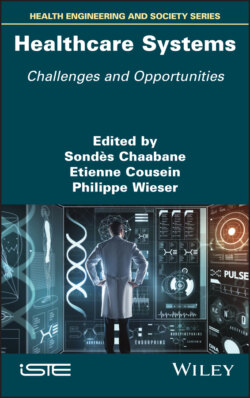Читать книгу Healthcare Systems - Группа авторов - Страница 2
Table of Contents
Оглавление1 Cover
2 Title Page
3 Copyright
4 Foreword
5 Preface
6 PART 1: Optimization and Simulation of Healthcare Systems Summary of Contributions – Part 1 1 Towards a Prototype for the Strategic Recomputing of Schedules in Home Care Services 1.1. Introduction 1.2. Literature review 1.3. Description of the problem 1.4. Resolution method 1.5. Presentation of the prototype 1.6. Tests and results 1.7. Conclusion and perspectives 1.8. References 2 Home Healthcare Scheduling Activities 2.1. Introduction 2.2. State of the art 2.3. Description of the proposed approach 2.4. Experiments and results 2.5. Conclusions and perspectives 2.6. References 3 Optimal Sizing of an Automated Dispensing Cabinet Under Adjacency Constraints 3.1. Introduction 3.2. Problem statement 3.3. Mathematical formulation 3.4. Application example 3.5. Conclusion 3.6. References 4 Validation of an Automated and Targeted Pharmaceutical Analysis Tool at the CHU de Liège 4.1. Introduction 4.2. Methods 4.3. Results 4.4. Discussion and conclusion 4.5. References 5 Simulation of Countermeasures in the Face of Covid-19 Using a Linear Compartmental Model 5.1. Introduction 5.2. The compartmental model 5.3. A linear SIR model 5.4. Results 5.5. Conclusion 5.6. References
7 PART 2: Digital and New Technologies for Health Services Summary of Contributions – Part 2 6 Towards a New Classification of Medical Procedures in Belgium 6.1. Introduction 6.2. Methodology 6.3. Results 6.4. Discussion 6.5. Conclusion 6.6. References 7 Digital Toolkit for the Ergonomic Evaluation of Workstations 7.1. Introduction 7.2. ProcSim and ergonomics 7.3. Ergonomic assessment process 7.4. Conclusion 7.5. References 8 Simulation on an RFID Interactive Tabletop with Tangible Objects of Future Working Conditions: Prospects for Implementation in the Hospital Sector 8.1. Introduction 8.2. State-of-the-art on the simulation of future working conditions 8.3. Proposal for a simulator on an interactive tabletop 8.4. Development of a first version of a simulator on an interactive tabletop 8.5. Application opportunities in the healthcare industry 8.6. Conclusion and perspectives in the healthcare industry 8.7. Acknowledgments 8.8. References 9 Robotic Geriatric Assistant: A Pilot Assessment in a Real-world Hospital 9.1. Introduction 9.2. Geriatric assessment: from needs to the proposed solution 9.3. Methodological approach: living lab approach 9.4. Pilot assessment 9.5. Conclusion 9.6. Acknowledgments 9.7. References 10 Perspectives on the Patient Experience (PX) of People with Disabilities in the Digital Age: From UX to Px 10.1. Introduction 10.2. State-of-the-art on Patient experience (PX) 10.3. Research methodology and proposal 10.4. Illustrations relating to the “user research” phase of the methodological framework 10.5. Case study: digital care journey of a patient with a disability 10.6. Conclusion 10.7. References
8 PART 3: Change Management and Organizational Innovations Summary of Contributions – Part 3 11 Jointly Improving the Experience of All Stakeholders in Hospital 4.0: The ICSSURP Initiative 11.1. Introduction 11.2. Digital transformation to Hospital 4.0 11.3. Essential qualities of information systems of Hospital 4.0 11.4. Towards a joint security, safety, usability, resilience and performance engineering initiative (ICSSURP) 11.5. Conclusion and perspectives 11.6. References 12 A Tool-based Approach to Analyze Operating Room Schedule Execution: Application to Online Management 12.1. Introduction 12.2. Methodology used to generate our approach 12.3. Current version of the proposed tool-based approach 12.4. Applied example of our tool-based approach at the Centre Hospitalier de Narbonne 12.5. Conclusion and perspectives 12.6. References 13 Planning Patient Journeys in Outpatient Hospitals to Support the Ambulatory Shift 13.1. Introduction 13.2. Background and state-of-the-art methods 13.3. State-of-the-art and field of application 13.4. Contribution 13.5. Discussion and perspectives 13.6. Conclusion 13.7. References 14 Treatment Protocols Generated by Machine Learning: Putting a Case Study of Hospitalization at Home into Perspective 14.1. Introduction 14.2. Context and perspective 14.3. The contribution of protocolization 14.4. Study and proposed methodology 14.5. Conclusion 14.6. References 15 Resilience of Healthcare Teams: Case Study of Two Cardiology Intensive Care Units 15.1. Introduction 15.2. Theoretical framework 15.3. Research methodology 15.4. Research results 15.5. Discussion 15.6. Conclusion 15.7. References
9 Conclusion and Perspectives
10 Glossary
11 List of Authors
12 Index
13 End User License Agreement
